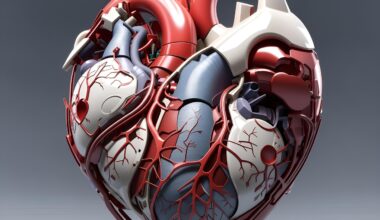Body Composition and Metabolic Rate in Athletes
Understanding body composition is vital for athletes aiming to enhance performance. Body composition refers to the percentages of fat, bone, water, and muscle in the human body. Athletes, particularly those involved in sports requiring strength, endurance, or agility, need to maintain optimal body composition for peak performance. Proper assessment methods include Dual-Energy X-ray Absorptiometry (DEXA), bioelectrical impedance analysis, and skinfold thickness measurements. Each method varies in accuracy, cost, and availability. Effective dietary strategies combined with exercise can aid in achieving desired body composition. For instance, a balanced intake of proteins, carbohydrates, and fats tailored to an athlete’s specific needs can significantly alter body composition favorably. Furthermore, understanding how muscle mass impacts metabolic rate is essential. A higher muscle mass increases basal metabolic rate (BMR), leading to improved energy expenditure, which can be crucial for athletes looking to maintain their weight while maximizing performance. Personalized nutrition and training plans can further enhance athletic body composition and overall health.
The Impact of Muscle Mass on Metabolism
Muscle mass plays an integral role in an athlete’s metabolic rate. As muscle is more metabolically active than fat, athletes with greater muscle mass will have a higher BMR. This enables them to burn more calories at rest and during physical activities. Furthermore, muscle tissue requires energy for maintenance and repair, further amplifying energy expenditure. Athletes often benefit from weight training to build and maintain muscle mass, contributing quantitatively to their overall metabolism. Training regimens must be carefully balanced with adequate recovery to prevent overtraining, which can negatively impact hormone levels and thus metabolic rate. Enhanced muscle mass can lead to improved performance in high-intensity sports and prolonged endurance in aerobic events. The recommended protein intake for athletes is higher than for the general population, supporting muscle synthesis and recovery. A combination of resistance training and appropriate dietary intake is essential to promote muscle growth effectively. By incorporating adequate macronutrients, particularly proteins, athletes can optimize their body composition while ensuring a high metabolic rate suitable for their sporting discipline.
Athletes competing at high levels strive for an optimal body composition that supports performance. This balance often involves careful monitoring of body fat percentages and muscle mass, as these two elements significantly affect overall efficiency in competitive sports. Assessments should be conducted regularly to track changes in body composition, helping athletes adapt their training and nutrition programs accordingly. Body fat percentages need to be sufficient for health yet minimized without compromising muscle mass. Periodization in training is critical; athletes must integrate different phases emphasizing muscle gain, fat loss, or maintenance. Enhanced metabolic activity often results from structured weight training regimens, subsequently impacting energy utilization and recovery. Proper recovery protocols should also be implemented to enable muscle repair and growth post-exercise. When evaluating body composition, hydration status must also be considered, as fluctuations can impact body weight and subsequent performance. It is vital for athletes to adopt a holistic approach to body composition management that includes not just training, but also nutrition, recovery, and lifestyle choices, ensuring a comprehensive framework for optimizing performance.
Nutrition’s Role in Body Composition
Nutritional strategies play a fundamental role in determining body composition among athletes. Correct dietary practices can help to maximize muscle mass while minimizing body fat percentage. A diet rich in whole foods, lean proteins, complex carbohydrates, and healthy fats supports these goals. Specific attention should be paid to nutrient timing, particularly concerning pre- and post-workout meals. Consuming carbohydrates before exercise can enhance performance and delay fatigue, while post-workout protein helps in muscle recovery. The importance of hydration cannot be overlooked; optimal fluid balance supports metabolic functions and can directly influence performance. Supplements can also complement dietary intake, providing critical nutrients that may enhance performance when used judiciously. Options like branched-chain amino acids, creatine, and omega-3 fatty acids have shown benefits for athletes. However, the focus should remain on whole foods as the primary source of nutrition. Additionally, athletes should be aware of their caloric intake to maintain goal-oriented body composition effectively. A registered dietitian specializing in sports nutrition can provide tailored advice to meet individual needs, crucial for both recreational and elite athletes.
Maintaining an ideal body composition necessitates a continuous focus on health and fitness. Athletes must take into account the balance between performance, recovery, and long-term well-being. Achieving an optimal balance requires a coordinated effort involving proper training, nutrition, and psychological well-being. Mental health plays a crucial role in an athlete’s success and, consequently, can influence body composition. Establishing routines and setting realistic goals help athletes stay motivated and aware of their physical condition. Monitoring and adjusting dietary intake further enhances adherence to a training regimen. Besides, awareness of the psychological factors like body image and social pressures is critical for athletes. Encouraging open communication regarding these issues within teams can foster a supportive environment. Periodic check-ins with sports psychologists may also be beneficial, allowing athletes to discuss their physical goals openly without stigma. By engaging in all aspects of health—including emotional, physical, and social—athletes create a solid platform for success. In the long run, cultivating a sustainable approach toward body composition results not just in improved performance but also in better overall health.
The Future of Body Composition Assessment
As technology continues to advance, the future of body composition assessment looks promising for athletes. State-of-the-art tools are being developed, ranging from smart scales to mobile applications that track body metrics. These advancements offer convenience and accessibility, enabling athletes to monitor their body composition in real-time. Continuous feedback through wearable technology can provide insights into not just body composition changes, but also overall health trends, aiding athletes in making informed decisions. Enhanced algorithms in body composition analysis software can lead to more accurate results, further helping in the development of personalized training and dietary programs. Moreover, the integration of artificial intelligence into these assessments may revolutionize how body data is analyzed and applied. AI can help in optimizing training programs by predicting performance outcomes based on individual body composition metrics. As more athletes adopt these technologies, there will be a shift towards data-driven decision-making. Coaches and sports scientists can leverage data analytics to fine-tune training regimens, ensuring that athletes can achieve their best possible body composition and performance.
In conclusion, body composition and metabolic rate form the foundation of athletic performance. Understanding the intricate relationship between muscle mass, fat percentage, and metabolic function allows athletes to tailor their lifestyle for optimal outcomes. Regular assessment and personalized training and nutrition programs are essential components of this process. By focusing on individual needs and making adjustments based on performance metrics, athletes can achieve and maintain their ideal body composition effectively. As knowledge advances and technology evolves, athletes are better equipped than ever to manage their body metrics. They can harness these tools to identify strengths and weaknesses, ultimately leading to improved overall performance. This comprehensive approach encompasses not only physical training but also mental health and support systems. Fostering a healthy body image and encouraging open discussion around body composition will further benefit athletes. To succeed in competitive sports, maintaining a balanced perspective towards body composition is crucial. It is not solely about aesthetics; it’s about optimizing performance and health. The future of body composition analysis is exciting, and its continued evolution will have profound impacts on athletic training.


